Key takeaways:
- Family narratives connect personal identity and heritage, prompting curiosity about one’s roots and values.
- Genetic evidence reinforces and sometimes challenges family stories, revealing unknown connections and cultural backgrounds.
- Different DNA testing methods, such as autosomal, Y-DNA, and mitochondrial DNA, provide insights into family history and heritage.
- Analyzing genetic results can deepen understanding of health traits and family dynamics, enriching one’s sense of identity and familial legacy.

Understanding family narratives
Family narratives are more than just stories; they are the threads that weave together our identities. Growing up, I often found myself listening to my grandmother recount tales of our ancestors. Those narratives not only connected me to my roots but also sparked a curiosity about who I truly am. I still remember how her stories made me feel a sense of belonging, prompting me to wonder: how much do these tales influence our present?
As I delved deeper into my family’s history, I realized that these narratives often contain truths and myths intermingled. For instance, I discovered a story about a rebellious ancestor who defied societal norms. The emotional resonance of that tale made me question how our family’s legacy shapes our values and choices today. Have you ever thought about how your family narratives have influenced your own life decisions?
Exploring family narratives often feels like piecing together a puzzle. Each story adds a layer of depth to understanding my heritage. I recall when I uncovered a letter detailing my great-grandfather’s struggles. It stirred a profound empathy within me. In moments like these, I’m reminded that our family histories are not just composed of dates and names; they are rich tapestries of human experience that resonate across generations.
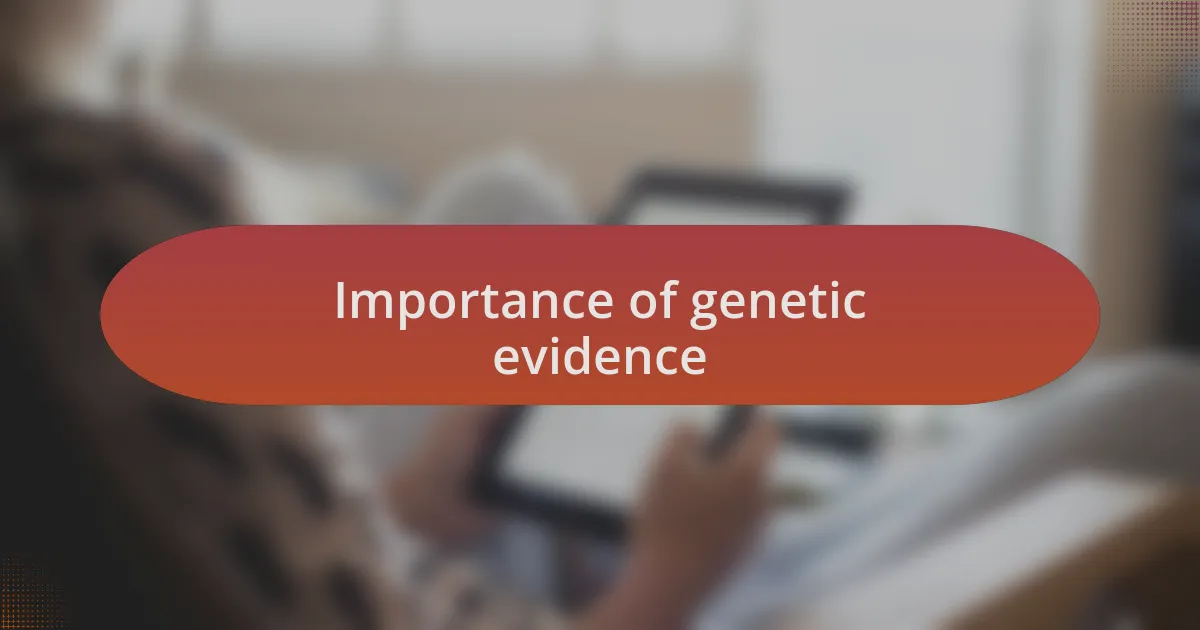
Importance of genetic evidence
Genetic evidence serves as a scientific foundation for understanding our family narratives, grounding these stories in tangible links. I remember when I first received my DNA test results; seeing the regions my ancestors hailed from brought my grandmother’s stories to life in a new way. It felt as if each percentage of my ancestry was a thread woven into the fabric of who I am today.
What struck me most about genetic evidence is its ability to reveal connections previously unknown. For instance, through genetic testing, I uncovered relatives I had never met, each one a living testament to the tales I had grown up hearing. It’s fascinating to think about how these connections can enrich our understanding of family dynamics, prompting questions about the legacy we inherit. Have you ever considered how your genetic background could open doors to new relationships or insights about your family’s journey?
Moreover, genetic evidence not only confirms narratives but also challenges them. A surprising discovery about my lineage revealed a different cultural background than what I had always believed. This realization prompted me to reflect deeply on my identity and the narratives I embraced. It made me wonder: how many other hidden stories lie within our genetic makeup, waiting to be uncovered?
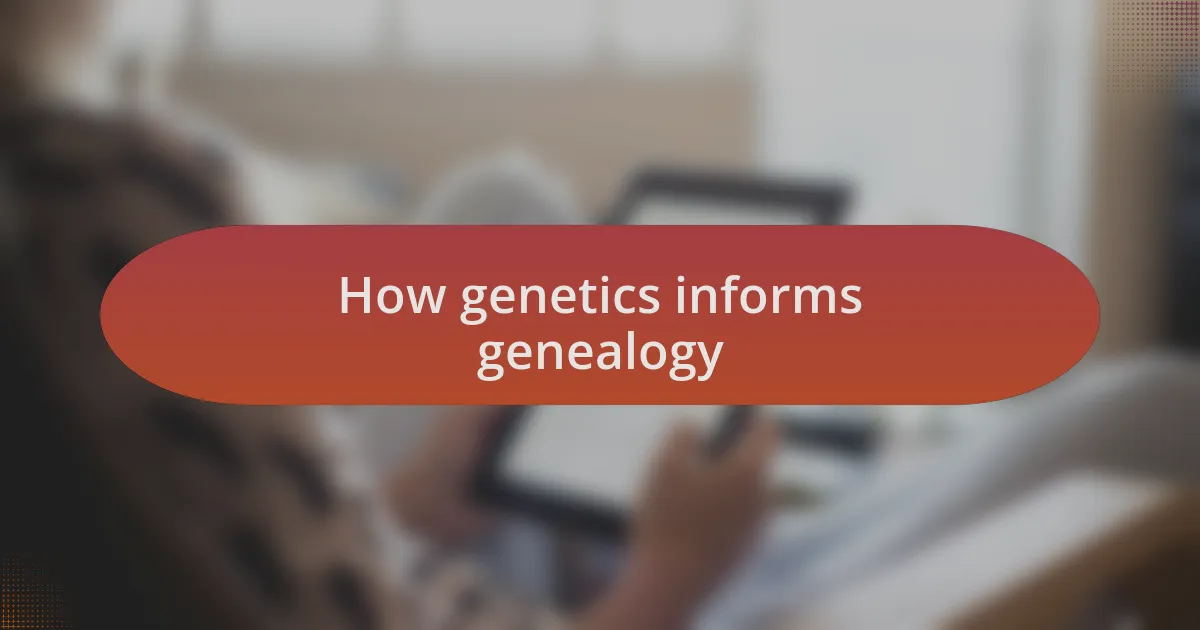
How genetics informs genealogy
Genetics plays a pivotal role in genealogy, serving as a bridge between our present selves and our ancestral past. I recall the moment I connected my DNA results with the names on my family tree, which suddenly transformed into living, breathing individuals. It’s incredible how a single genetic match can spark a cascade of stories, each person potentially holding key pieces to our shared history.
What truly fascinates me is how genetic markers can trace migration patterns, painting a vivid picture of our ancestors’ journeys. When I explored my genetic ancestry, I noticed certain markers that aligned with historical migrations, revealing how my ancestors likely traveled across continents seeking new lives. This realization was more than a simple connection; it was a profound reminder of the resilience and adventure embedded in my lineage. Have you ever thought about the stories your genes might tell, highlighting bravery in the face of adversity?
Additionally, genetics often unveils surprising surprises, challenging long-held beliefs about family history. In my case, discovering unexpected heritage changed my perspective entirely. It led me to attend cultural events associated with this newfound background, enriching my understanding of not just my ancestry, but also the diverse tapestry of human experience. How does uncovering an unexpected branch of your family tree resonate with your sense of identity? Each revelation leaves room for deeper exploration and appreciation of where we come from.
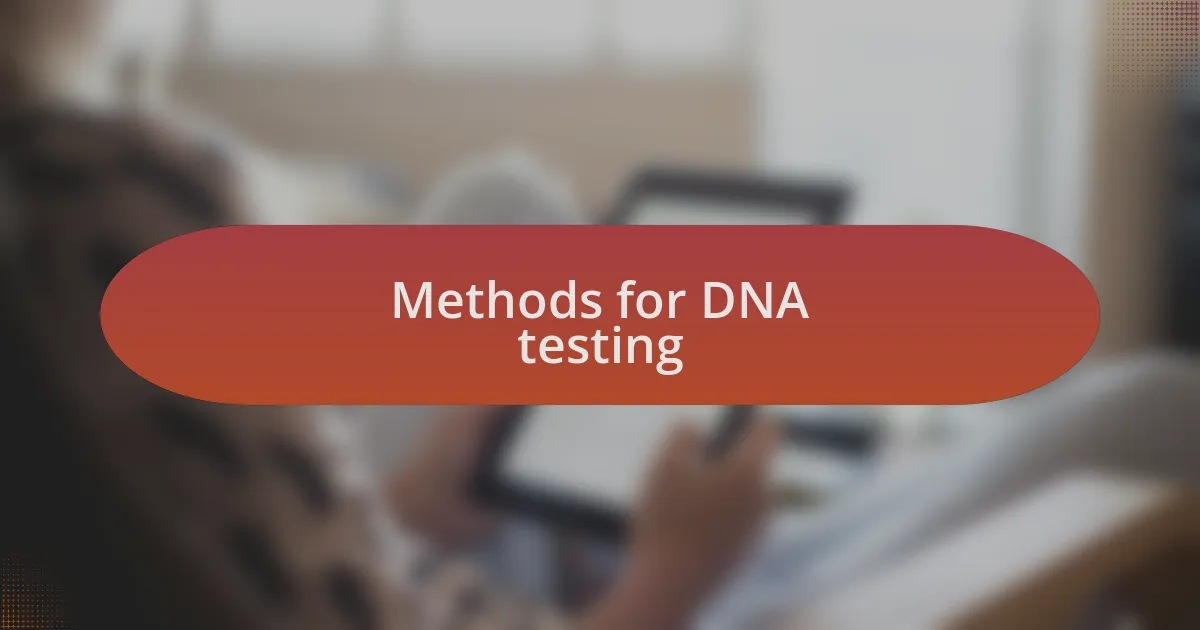
Methods for DNA testing
DNA testing methods have evolved significantly over the years, providing multiple avenues for exploration. One popular approach is autosomal DNA testing, which analyzes the combined DNA inherited from all four grandparents. When I first received my results from an autosomal DNA test, I was amazed to uncover relatives I never knew existed, including a distant cousin who became a valuable resource for learning about our family history.
Another method I found intriguing is Y-DNA testing, which traces the paternal lineage through the Y chromosome. This method is particularly useful for men looking to explore their father’s side of the family. I remember discussing this with a friend who discovered fascinating details about his family, extending back several generations, making him feel more connected to his roots than ever before. Have you considered how exploring paternal lines could deepen your understanding of your ancestry?
Finally, mitochondrial DNA testing offers insights into the maternal lineage, tracing ancestry through the mitochondrial DNA passed down by mothers. This method not only illuminates the female line but often brings emotions to the surface as you realize how many women have carried familial legacies through the ages. I felt a wave of reverence when learning about my maternal ancestors, each of whom contributed to my existence. Isn’t it moving to think about the strong women who came before us, shaping our identities in ways that go beyond mere genetic connections?
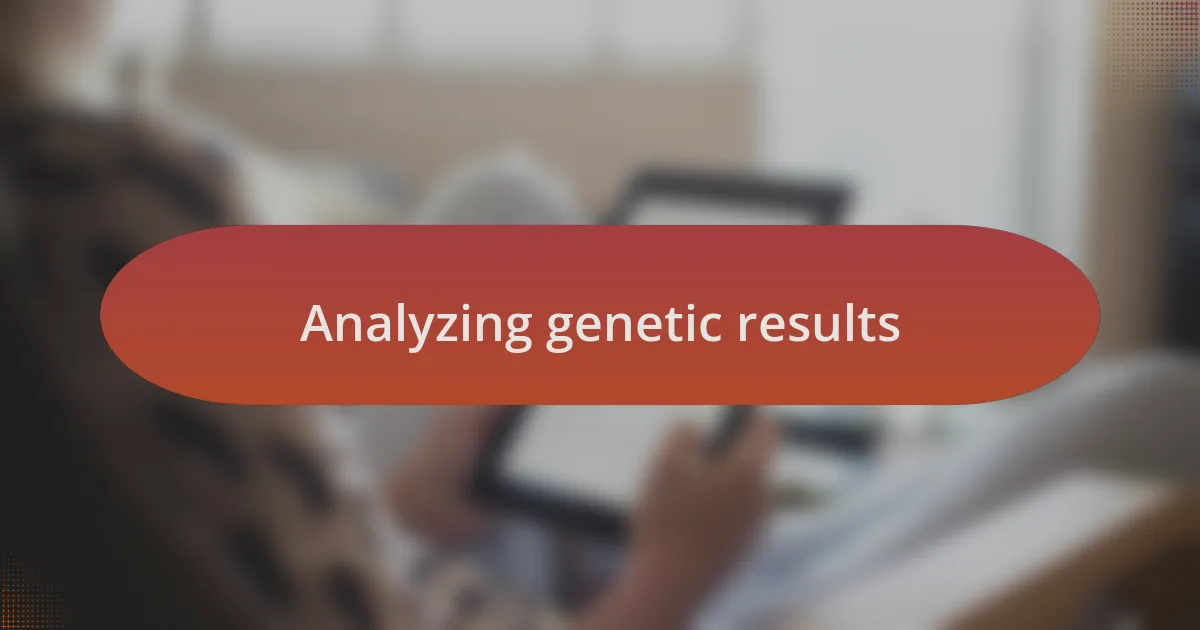
Analyzing genetic results
Analyzing genetic results can be both enlightening and overwhelming. When I first sifted through my test results, I was surprised by the sheer amount of information available. It wasn’t just about matches; it was about narratives waiting to be unveiled. Each percentage of ethnicity felt like a breadcrumb leading me deeper into the story of who I am. Have you ever felt a spark of recognition when seeing a familiar place tied to your heritage?
As I compared my results with family members, I noticed patterns and discrepancies that spurred rich conversations about our shared history. This process was more than mere statistics; it was a way to bridge gaps in understanding. For example, discussing why my father’s side showed a higher percentage of Irish ancestry sparked stories about his grandparents’ journey across the ocean. How powerful it is to connect numerical results with real-life experiences!
Additionally, examining genetic health markers provided insights that transcended genealogy. My own results highlighted predispositions I never considered, prompting me to reflect on my family’s history of certain health conditions. This led me to a deeper inner dialogue about how our past influences our present and future. Have you ever wondered how knowledge of health traits might empower you to make informed choices? I certainly have, and it’s a journey I continue to navigate as I explore the implications of my genetic story.
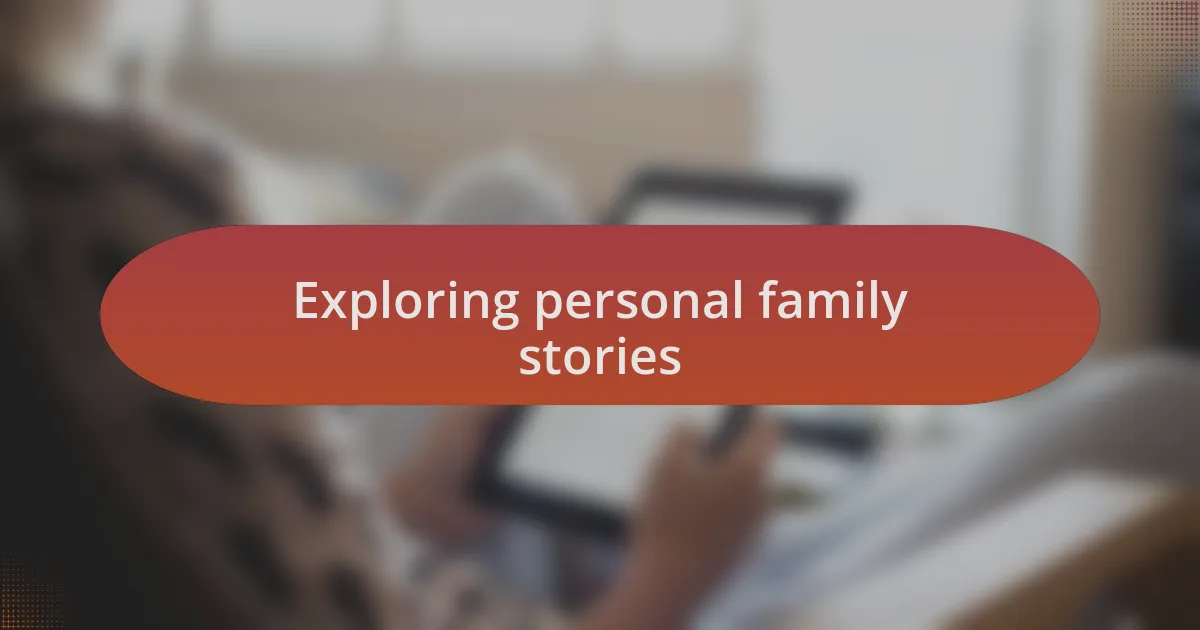
Exploring personal family stories
Uncovering family stories through genetics often feels like fitting together a complex puzzle. I remember the moment I uncovered an unexpected connection to a distant cousin who shared not just DNA but also childhood memories of the same small town. Have you ever stumbled upon a piece of information that completely changes your perspective on your family’s past? It was in that instant that I realized how shared experiences and genetic ties intertwine, shaping our collective identity.
As I delved deeper, I discovered tales of resilience and adventure that had been passed down through generations, albeit in fragmented whispers. For instance, one particular family legend told of an ancestor who bravely emigrated in search of a better life, a story that resonated deeply with my own aspirations. Learning these stories through the lens of genetic evidence made them feel more tangible. Isn’t it fascinating how each of our family narratives is woven together by shared threads, both genetic and experiential?
These narratives have a way of transforming our understanding of family dynamics. Reflecting on my family’s history, I found repeated themes of overcoming adversity and the unwavering bond of support. This revelation prompted me to think about how our ancestors’ experiences influence our values today. What legacy do we carry forward? By exploring these personal family stories, I not only connected with my roots but also gained a heartfelt appreciation for the strength embedded in my lineage.
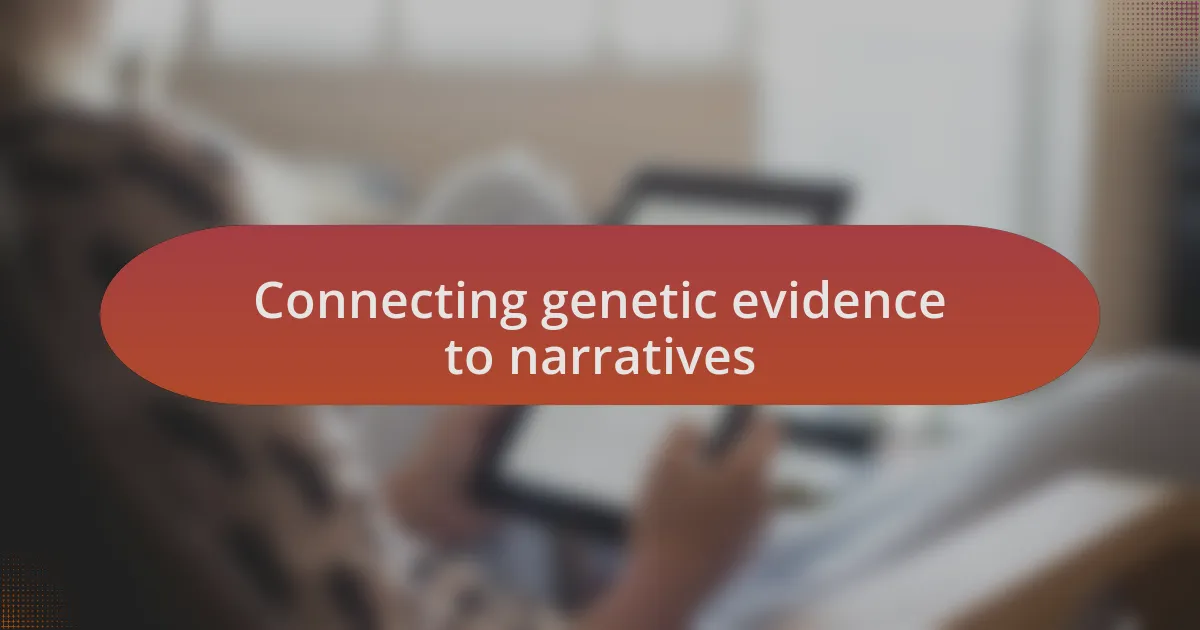
Connecting genetic evidence to narratives
Connecting genetic evidence to narratives requires a keen eye for detail and a willingness to embrace new discoveries. I recall tracing my Y-DNA lineage and finding an unexpected match with a gentleman who not only shared my last name but also a shared passion for storytelling. It was as if the genetic link ignited a curiosity within me—what experiences had shaped this man’s life, and how did they relate to my own? It made me wonder: how often do we overlook the narratives that our DNA can reveal?
As I compared genetic results with family trees, I stumbled upon a shocking realization about an ancestor’s involvement in a historical event. This discovery turned what was once a vague family story into a vivid account, breathing life into a name I had known only as a fleeting mention in old letters. That moment was pivotal; it urged me to dig deeper. Could these shared genetic markers be echoes of events that forged our identities?
Moreover, the conversations sparked by these connections opened emotional doors for me. I felt an overwhelming sense of belonging, realizing that my family’s legacy isn’t merely written in documents but also etched in our genes. With each new revelation, I realized that these narratives serve as a powerful bridge between past and present, reminding me just how intertwined our lives are. Isn’t it incredible to think how the strands of our DNA carry stories waiting to be uncovered?